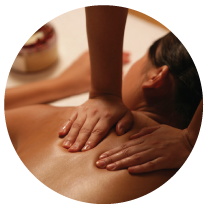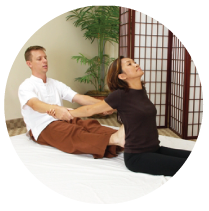Massage Therapy
Conditions Massage Therapy Can Alleviate
Massage Therapy is a comprehensive range of techniques consisting of hands-on manipulation of the soft tissues of the body. It targets muscles, connective tissue, tendons, ligaments and joints for the purpose of optimizing health and reducing pain. Assessment and treatment can include orthopedic and neurological tests, soft tissue manipulation, remedial exercise and client education.
The purpose of Massage Therapy is to prevent, develop, maintain, rehabilitate or augment physical function or relieve pain. Massage therapy helps alleviate soft tissue discomfort associated with everyday and occupational stresses, muscular over-use and many chronic pain conditions. If employed after trauma or injury, it can reduce the development of harmful gait or movement compensations which could otherwise interfere with bio-mechanical health and function. Through a diverse series of techniques and approaches, massage can help relieve an array of pain syndromes originating from stress or muscular overuse..
Benefits of Massage Therapy
There are tremendous benefits with regular Massage Therapy treatments. It can aid in relaxation and stress reduction, minimize muscle tension, and alleviate chronic pain. Therapeutic Massage can enhance life experiences by reducing pain and increasing emotional and physical well-being.
Massage is useful for people of all ages. While it can help with injuries, illness and stress, the true strength of Massage Therapy is found in prevention and treatment of chronic pain conditions before they develop into more serious and long term versions of themselves. Massage can benefit both acute and chronic injuries and stress..
Therapeutic massage can play an important part in health maintenance by:
- Reducing or eliminating pain
- Improving joint mobility
- Improving circulation
- Improving immune system function
- Increasing lymphatic drainage
- Reducing depression and anxiety
- Reducing muscle tension
- Increasing body awareness
Massage Therapy helps with:
- Inflammatory conditions such as arthritis and tendonitis.
- Stress relief and associated conditions.
- Headaches and migraines.
- Muscle and related conditions such as spasms, strains and sprains.
- Back pain.
- Repetitive strain injury.
- Circulatory and Respiratory problems.
- Pregnancy and labour discomfort.
- Post-injury and post surgical rehabilitation.
Yes, massage is appropriate for individuals of all ages, including infants, children, and the elderly; however, there are some conditions for which massage therapy is not appropriate. A qualified Massage Therapist (RMT or MT) is trained to recognize these cases.
No. Your comfort is of the utmost importance, whether that is in the context of the clothing you wear or the treatment you receive. The practitioner can provide treatment whether you elect to remove none, some, or most of your clothing. All practitioners are trained in proper draping procedures to ensure that your privacy is respected and maintained at all times – before, during and after treatment.
Your feedback during the session is paramount to receiving safe and effective treatment. Your consent is sought before treatment. If you are uncomfortable at any time during the treatment, let your practitoiner know. Whether that discomfort involves the treatment approach or any pain you may experience during the session, your therapist values your feedback during and after the session. Be sure to discuss any chronic or acute injuries you may have prior to the treatment.
As with many types of treatment, there are times when Massage Therapy can cause slight to moderate discomfort. If tolerable, this is not harmful, and can actually be beneficial in speeding the healing process, depending on the stage and severity of the injury. A comfort scale can be established and the therapist will always work within your level of preference while working towards your treatment goals.
One treatment can often be enough for symptom relief. Massage is also beneficial for injury and stress prevention as well as treatment. In reviewing your health information and discussing your health goals, yourself and your practitioner can establish a plan for care which fits your unique situation. Your practitioner is your professional partner in helping meet your health goals, whether that be in recovery or for health maintenance..
Before receiving treatment, you will complete a confidential health history form as part of your assessment. It is important that this is completed accurately, so the practitioner knows if you have any medical conditions or are taking any medications that may cause them to modify their apporach to be sure to provide safe and effective treatment. They will listen to your concerns and assess any symptoms you may have before administering treatment.
Massage is not publicly funded or covered by the health care system in Ontario or Canada. One wonders what positive financial and health impacts might arise if a preventative approach such as Massage Therapy were included in OHIP, like many other health services. That question shall unfortunately remain hypothetical for the time being.
Many extended employee health plans include Registered Massage Therapy coverage. In this case, the covered individual pays for the treatment upon the provision of service, and submits the expense to their health insurance provider for reimbursement. If in doubt, check with your HR department. Some plans require a medical note for re-imbursment, available from and MD, but most do not require this letter of MD referral.
RMT services can also qualify under medical for a tax deduction with Revenue Canada at tax time. Check with your accountant or RevCan for details.
Yes, your records will be kept in the strictest of confidence, in accordance with file storage and protection protocols that all Regulated Health Professionals in Ontario are required to follow.
Traditional Thai Massage
Traditional Thai Massage is an extraordinary tool for biomechanical alignment and energetic coherence, originating from the time of the Buddha. Nuad Phan Boran as is it called in Thailand, correctly translates as Ancient Massage or Traditional Massage. More widely known today as Thai Massage, it is seen as a practical application of the Buddhist principle of ‘Metta’ or loving kindness, forming the cornerstone of a quietly effective healing approach for body, mind and soul.
Elements of Yoga and Ayurveda from India are combined with ancient healing principles to balance the flow of Chi energy through the body and mind. It is performed on comfortable mats or a massage table while the client is fully clothed. Sessions usually last for at least one hour, and can be as long as 2 or 3 hours.
Thai Massage consists of a series of interactive, flowing movements, stretches and rhythmic massage points along the body’s energy lines. The experience is often deeply meditative, and can be a profound and expansive experience.
Benefits of Thai Massage
- Helps detoxify the body and boost immune system function.
- Increases circulation, balances blood pressure.
- Relaxes sore muscles and joints.
- Increases flexibility and biomechanically aligns posture.
- Aligns the 7 chakras.
- Improves breathing.
- Improves balance.
- Helps increase concentration and creativity.
- Reduces and relieves stress and anxiety.
- Increases energy and endurance in physical activities.
- Strengthen the body’s internal Chi energy (the life force that flows through our organs and meridians).
History of Thai Massage
Traditional Thai Massage is a therapeutic technique that dates back thousands of years. Its’ precise origin is unknown, but practitioners traditionally trace the lineage to Chivaka Komarapatr. A private doctor and friend of the Buddha, he is said to have successfully used massage and stretching techniques along with herbal and other remedies to treat ailments and conditions amongst the nuns and monks that were traveling with the Buddha.
At that time, medical institutions and practices of the monastery were integral parts of the religious system. When Buddhism reached Thailand in the 3rd or 2nd century BC, temples were built with adjacent dispensaries and medical schools.
A long time has passed and thus, much historical evidence have disappeared. Most texts have been lost during various invasions. Only fragments of the existing precious medical texts survived. These were used as a basis for the famous epigraphs at Wat Po in Bangkok, in order to pass on the techniques to future generations.
Thai Massage
Traditionally Thai Massage is done on floor mats, but elements of the practice are being effectively adapted by practitioners more accustomed to working on a massage table or bed. However, due to leverage advantages, many of the advanced movements and stretches are done most effectively on the floor. Both options are available for treatment, mats or massage table.
Comfortable and flexible yoga or athletic clothes are best to accommodate the twisting and stretching movements in the session. A pair of Thai pants are provided if you do not arrive wearing flexible clothing.
Traditionally, Thai Massage treatments are one and a half to 3 hours long. In the west we are more often busy and rushed, so sessions are often an hour or 90 minutes long. Longer sessions are also available.
Since the main objective is energy balancing, the physical moves become part of a deeper, more meditative spiral of healing, resulting in a profoundly deep and integrative sense of physical, mental and spiritual well-being for both giver and receiver.
Stress relief, revitalization and a euphoric feeling of overall wellbeing are most often descriptors for the benefits of the treatment. Physiologically, the body is encouraged towards bio-mechanical alignment, boosting flexibility and circulation. This techniques helps connect to our somatic sensation of being fully present in our body.
Since the sequence and approach is unique for each individual and each treatment, it is safe, with certain modifications when necessary. Though pregnancy is a magical process of coherence and teamwork, it is not advised to receive Thai Massage pregnancy, since the body manufactures hormones trimester 2 and 3 that loosen ligaments to prepare for childbirth. Ligaments serve multiple purposes, including protection from over-stretching. Therefore Thai Massage is not indicated during pregnancy.
How often you receive Thai Massage is a personal choice. Since your body is a reflection of your living experience, you know best! Initially, clients may come more frequently for bio-mechanical balancing work or to accomodate injury recovery. As the body responds to treatment, less frequent visits are usually necessary. Regular clients receive weekly, bi-weekly, monthly or quarterly, depending on multiple factors such as health and finance.
Since the treatment may involve pressing points around the abdomen, it is better not to eat a heavy meal immediately before the session. Snacks are ok. To allow the process to continue after the session, it is better not to eat heavily or do strenuous exercise immediately afterwards. Drinking warm lemon water or hot tea in the winter, or cold in the summer, is highly beneficial, since liquids help flush out toxins that may have been ‘stirred up’ for elimination during the treatment.
It is said to have originated in India. Some say it grew out of the ancient healing systems practiced in South India in the region now known as Kerala. Later, after becoming a part of ancient Ayurveda, it existed in Northern India (now Nepal). The physician Chivaka Komarapatr, a private doctor of the Buddha used Thai Massage along with herbal and other remedies, to treat ailments and conditions amongst the monks that were traveling with the Buddha. This spread Buddhism and these medicinal techniques all over Southeast Asia. In terms of hard facts pointing to it’s date of origin, it is difficult to be sure because it’s so ancient. From what we know, this healing art has been practiced for about 4000 years!


